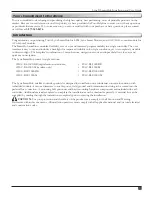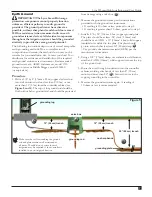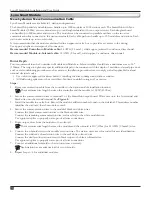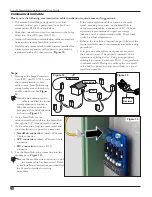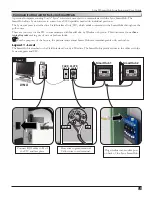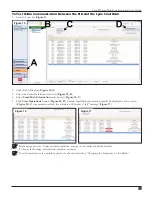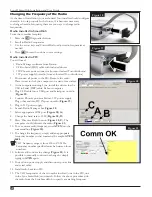
7
Lynx® SmartHub Installation and User Guide
Earth Ground
!
IMPORTANT! The Lynx SmartHub surge
protection components cannot properly function
unless an efficient pathway to earth ground is
provided. The ground path must be as direct as
possible, without sharp bends and should not exceed
10 Ohm resistance (when measured with an earth
ground resistance device). All electrical components
throughout the irrigation system should be grounded
similarly to provide the same ground potential.
The following instructions depict one of several acceptable
earth grounding methods. Due to variables in soil
composition and terrain, the method shown may not be
suitable for your installation site. Contact your local Toro
distributor for assistance and availability of the required
earth ground resistance test instrument. Recommended
ground testers are: AEMC Instruments, model 3710
clamp-on tester, or Biddle Megger, model 250260
(or equivalent).
Procedure
1. Drive a 5/8” by 8’ (17mm x 2.5m) copper clad steel rod
into well moistened soil not less than 8’ (2.5m) or not
more than 12’ (3.7m) from the controller cabinet (see
Figure 5 and 6
). The top of the ground rod should be
flush with or below ground level, and should be protected
from damage using a valve box (
A
).
2. Measure the ground resistance per the instructions
provided with the ground test instrument.
• If reading is 10 ohms or less, proceed to step 4.
• If reading is greater than 10 ohms, proceed to step 3.
3. Install a 4” by 96” (10cm x 2.5m) copper ground plate.
The plate should be at least .06” thick (1.5mm) and
should have a 6 AWG x 12’ (10mm² x 4m) solid copper,
insulated wire welded to the plate. The plate should
go into a trench that is at least 30” (80cm) deep (
B
). Use ground enhancement material (GEM) per the
manufacturer’s directions.
4. Using a 5/8” (17mm) clamp or exothermic-weld fastener,
attach an 8 AWG (10mm²) solid copper wire near the top
of the ground rod.
5. Route the wire through conduit and into the controller
cabinet, avoiding wire bends of less than 8” (20cm)
radius and more than 90° (
C
). Secure the wire to the
copper ground lug in the controller.
6. Measure the ground resistance again. A reading of
10 ohms or less is recommended.
A
B
C
Figure 5
Make sure the soil surrounding the ground
rod and plate remains well moistened at
all times. The addition of some form of
irrigation may be required if the controller is
installed in a non-irrigated location.
grounding rod
no sharp bends
valve box
grounding lug
grounding plate
30” (80 cm) trench
12” (30 cm) trench
12” (30 cm) trench



